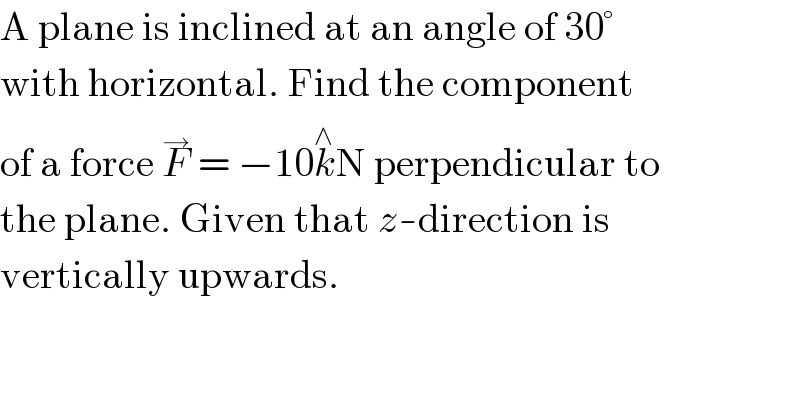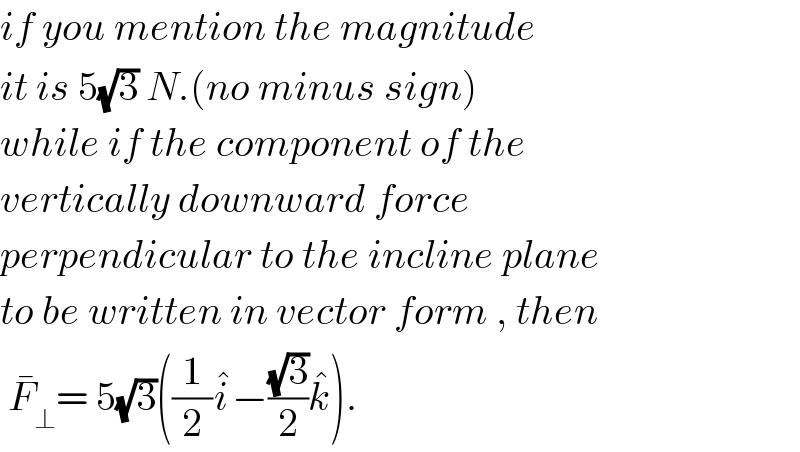Question Number 14923 by Tinkutara last updated on 05/Jun/17

$$\mathrm{A}\:\mathrm{plane}\:\mathrm{is}\:\mathrm{inclined}\:\mathrm{at}\:\mathrm{an}\:\mathrm{angle}\:\mathrm{of}\:\mathrm{30}° \\ $$$$\mathrm{with}\:\mathrm{horizontal}.\:\mathrm{Find}\:\mathrm{the}\:\mathrm{component} \\ $$$$\mathrm{of}\:\mathrm{a}\:\mathrm{force}\:\overset{\rightarrow} {{F}}\:=\:−\mathrm{10}\overset{\wedge} {{k}}\mathrm{N}\:\mathrm{perpendicular}\:\mathrm{to} \\ $$$$\mathrm{the}\:\mathrm{plane}.\:\mathrm{Given}\:\mathrm{that}\:{z}-\mathrm{direction}\:\mathrm{is} \\ $$$$\mathrm{vertically}\:\mathrm{upwards}. \\ $$
Answered by ajfour last updated on 10/Jun/17

$$\bar {{F}}_{\bot} =\left(\mathrm{10cos}\:\mathrm{30}°\right)\left(\mathrm{sin}\:\mathrm{30}°\:\hat {{i}}−\mathrm{cos}\:\mathrm{30}°\:\hat {{k}}\:\right){N} \\ $$$$\:\:\:\:\:=\:\frac{\mathrm{10}\sqrt{\mathrm{3}}}{\mathrm{2}}\left(\frac{\mathrm{1}}{\mathrm{2}}\hat {{i}}−\frac{\sqrt{\mathrm{3}}}{\mathrm{2}}\:\hat {{k}}\:\right){N} \\ $$$$\:\:\:\:\:=\:\frac{\mathrm{5}\sqrt{\mathrm{3}}}{\mathrm{2}}\left(\hat {{i}}−\sqrt{\mathrm{3}}\:\hat {{k}}\:\right){N}\:. \\ $$$$\:\mid\bar {{F}}_{\bot} \mid=\mathrm{5}\sqrt{\mathrm{3}}\:{N}\:. \\ $$
Commented by Tinkutara last updated on 10/Jun/17

$$\mathrm{Sir},\:\mathrm{wouldn}'\mathrm{t}\:\mathrm{it}\:\mathrm{will}\:\mathrm{be}\:−\mathrm{5}\sqrt{\mathrm{3}}\overset{\wedge} {{k}}\:\mathrm{N}? \\ $$
Commented by ajfour last updated on 10/Jun/17

$${question}\:{is}\:{wrongly}\:{framed}.. \\ $$$${if}\:{force}\:{is}\:\bot\:{to}\:{incline}\:{plane}\:,\:{is} \\ $$$$\:{the}\:{force}\:{along}\:{z}\:{axis},\:{how}\:{is}\: \\ $$$${then}\:{the}\:{inclined}\:{plane}\:{oriented}\:? \\ $$
Commented by Tinkutara last updated on 10/Jun/17

$$\mathrm{Why}\:\mathrm{kilo}\:\mathrm{N}?\:\mathrm{I}\:\mathrm{was}\:\mathrm{saying}\:\mathrm{it}\:\mathrm{would}\:\mathrm{be} \\ $$$$−\mathrm{5}\sqrt{\mathrm{3}}\:\mathrm{N}\:\mathrm{or}\:\mathrm{not}?\:\left(\mathrm{minus}\:\mathrm{sign}\right) \\ $$
Commented by ajfour last updated on 10/Jun/17

$${if}\:{you}\:{mention}\:{the}\:{magnitude} \\ $$$${it}\:{is}\:\mathrm{5}\sqrt{\mathrm{3}}\:{N}.\left({no}\:{minus}\:{sign}\right) \\ $$$${while}\:{if}\:{the}\:{component}\:{of}\:{the} \\ $$$${vertically}\:{downward}\:{force}\: \\ $$$${perpendicular}\:{to}\:{the}\:{incline}\:{plane} \\ $$$${to}\:{be}\:{written}\:{in}\:{vector}\:{form}\:,\:{then} \\ $$$$\:\bar {{F}}_{\bot} =\:\mathrm{5}\sqrt{\mathrm{3}}\left(\frac{\mathrm{1}}{\mathrm{2}}\hat {{i}}−\frac{\sqrt{\mathrm{3}}}{\mathrm{2}}\hat {{k}}\right). \\ $$
Commented by Tinkutara last updated on 11/Jun/17

$$\mathrm{Thanks}\:\mathrm{Sir}! \\ $$
